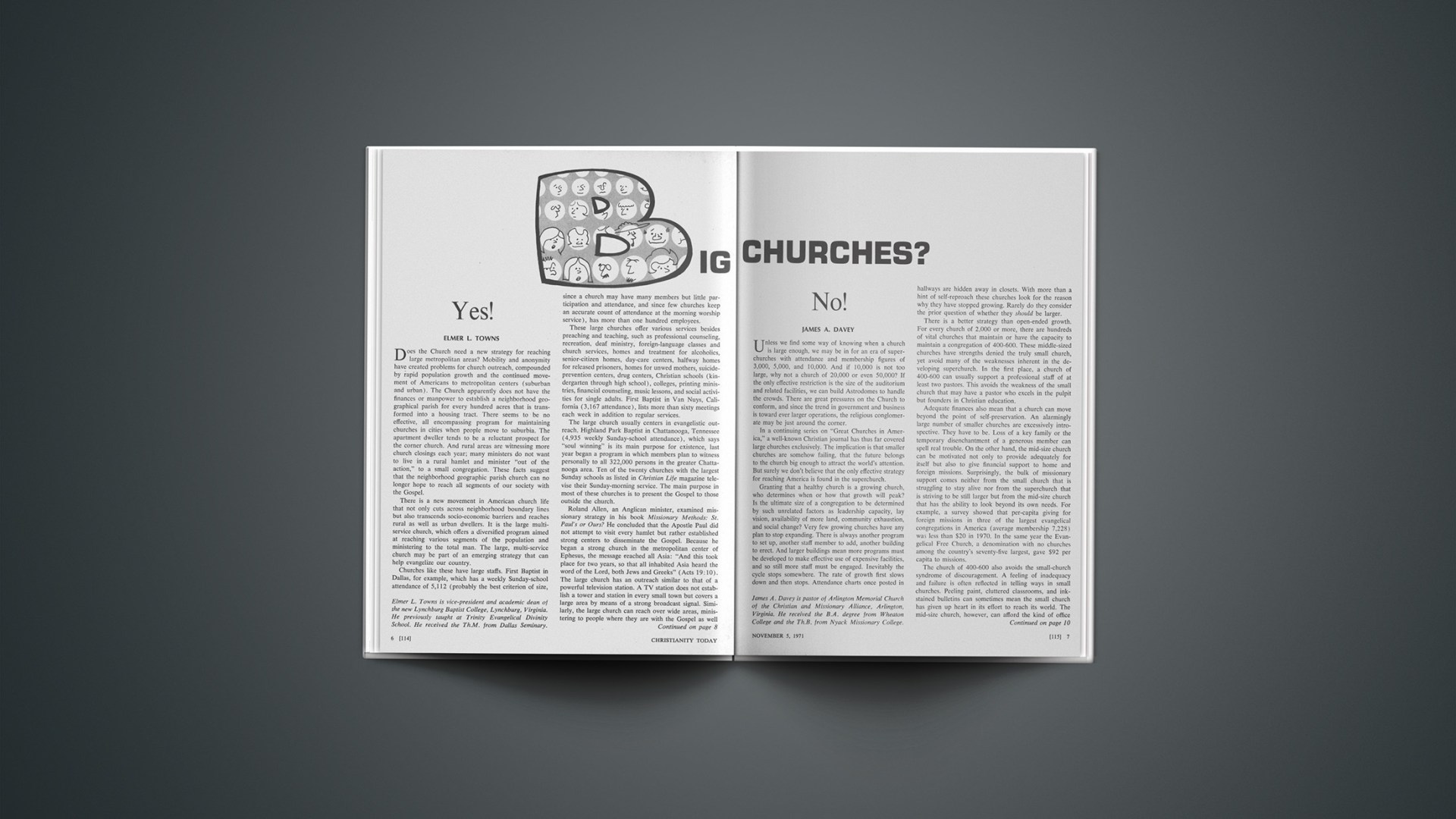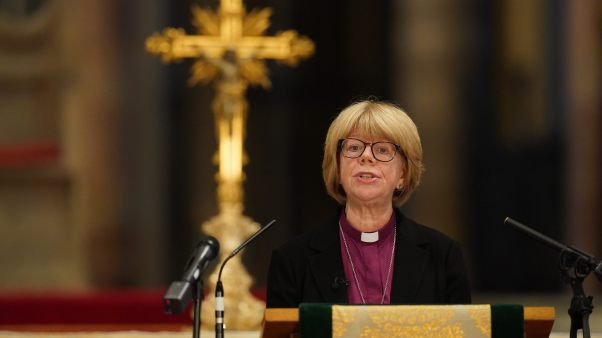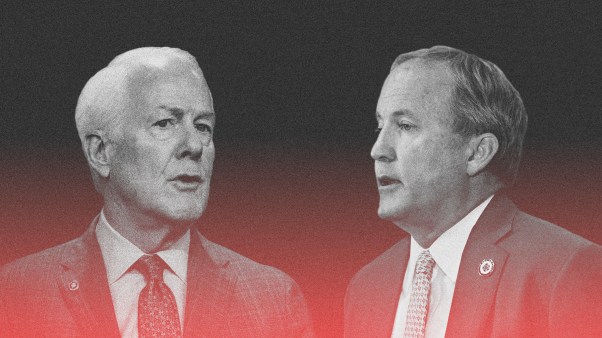Unless we find some way of knowing when a church is large enough, we may be in for an era of superchurches with attendance and membership figures of 3,000, 5,000, and 10,000. And if 10,000 is not too large, why not a church of 20,000 or even 50,000? If the only effective restriction is the size of the auditorium and related facilities, we can build Astrodomes to handle the crowds. There are great pressures on the Church to conform, and since the trend in government and business is toward ever larger operations, the religious conglomerate may be just around the corner.
In a continuing series on “Great Churches in America,” a well-known Christian journal has thus far covered large churches exclusively. The implication is that smaller churches are somehow failing, that the future belongs to the church big enough to attract the world’s attention. But surely we don’t believe that the only effective strategy for reaching America is found in the superchurch.
Granting that a healthy church is a growing church, who determines when or how that growth will peak? Is the ultimate size of a congregation to be determined by such unrelated factors as leadership capacity, lay vision, availability of more land, community exhaustion, and social change? Very few growing churches have any plan to stop expanding. There is always another program to set up, another staff member to add, another building to erect. And larger buildings mean more programs must be developed to make effective use of expensive facilities, and so still more staff must be engaged. Inevitably the cycle stops somewhere. The rate of growth first slows down and then stops. Attendance charts once posted in hallways are hidden away in closets. With more than a hint of self-reproach these churches look for the reason why they have stopped growing. Rarely do they consider the prior question of whether they should be larger.
There is a better strategy than open-ended growth. For every church of 2,000 or more, there are hundreds of vital churches that maintain or have the capacity to maintain a congregation of 400–600. These middle-sized churches have strengths denied the truly small church, yet avoid many of the weaknesses inherent in the developing superchurch. In the first place, a church of 400–600 can usually support a professional staff of at least two pastors. This avoids the weakness of the small church that may have a pastor who excels in the pulpit but founders in Christian education.
Adequate finances also mean that a church can move beyond the point of self-preservation. An alarmingly large number of smaller churches are excessively introspective. They have to be. Loss of a key family or the temporary disenchantment of a generous member can spell real trouble. On the other hand, the mid-size church can be motivated not only to provide adequately for itself but also to give financial support to home and foreign missions. Surprisingly, the bulk of missionary support comes neither from the small church that is struggling to stay alive nor from the superchurch that is striving to be still larger but from the mid-size church that has the ability to look beyond its own needs. For example, a survey showed that per-capita giving for foreign missions in three of the largest evangelical congregations in America (average membership 7,228) was less than $20 in 1970. In the same year the Evangelical Free Church, a denomination with no churches among the country’s seventy-five largest, gave $92 per capita to missions.
The church of 400–600 also avoids the small-church syndrome of discouragement. A feeling of inadequacy and failure is often reflected in telling ways in small churches. Peeling paint, cluttered classrooms, and ink-stained bulletins can sometimes mean the small church has given up heart in its effort to reach its world. The mid-size church, however, can afford the kind of office tools and buildings it needs to provide a well-rounded ministry to the whole man. Such a ministry is possible, not only because of adequate financing, but also because a leadership pool either exists or can be developed that will provide trained workers.
Perhaps the greatest advantage of the mid-size church is its ability to provide diverse expression without losing personal contacts. In such a congregation, the pastor can know everyone by name. More important, he can know something about each person, visit in his home, share his joys and sorrows. This kind of contact still has value, not only for the pastor, who must preach to real people, but also for the layman, who learns that Sunday’s preacher is more than a good actor, that he, too, is flesh and blood.
There are extraordinary pastors who can personalize their ministry to the thousands. But very few people in their congregations will share their gift. For most of these, worship and fellowship activities will involve a few friends and a great many strangers. A young man recently wrote me about the appeal of a smaller church in which he had worshiped. “It seems that progress is actually retrogression. You feel yourself to be a dignified part of something only when you can identify the other parts. That ‘at home’ feeling increases with familiarity. And as a church gets bigger … well, you’ve seen what happens. When you feel lost in church you are really lost.”
In most churches the Sunday school is the place where people get to know one another best. But a disturbing trend is the number of large churches reporting just one or two adult classes. It is now possible to feel lost in Sunday school as well.
For many churchgoers, the prospect of being a number on a church’s computer tape activated by a contribution, birth, death, or some other vital statistic is somewhat disquieting. The world is depressingly depersonalized as it is, and for the Church to follow this trend is to eliminate one of its potential appeals to modern man.
A recent bulletin from one of the largest churches in the South announced nineteen activities for the week. As far as this reader could observe, only the Sunday church services were designed to involve more than one age level at a time. Even then, those younger than junior high were excluded. It seems that the larger the church, the more thoroughly it segregates its people by age and interest. If the Church is not to accentuate today’s generation gap, it seems that the smaller or mid-size church will have to be the trailbreaker. In most larger churches, couples with toddlers never get to know their older counterparts with teen-age children; people who are single, widowed, or divorced are rarely involved with families; and no one except the deaconesses and the minister of visitation knows the senior citizens. The mid-size church may not be able to offer a fellowship group for every special interest, but it may have the potential for producing greater appreciation for the diversity there is in the Body of Christ.
The person who wants to “worship and run” will be decidedly unhappy in a church where he can be known and identified. Too many Christians seem to crave great preaching and great music and are willing to pay any price except personal involvement to get it. They take up their weekly watch on the end of a pew, contribute to the offering, rejoice in the sermon, shake hands with a greeter (whose name they probably do not know), and are gone for another week. Such Christians will always be with us, perhaps, but we ought not to structure our church strategy to make it easy to be an invisible member of the Body of Christ.
The church that encourages long-distance commuting and buses large numbers from distant communities is unconsciously creating a warped picture of the Church unless it also provides opportunity for vital service and fellowship in those distant communities. The extent of the problem for the very large church is often dramatized by the great disparity between Sunday-school attendance and the turnout for other gatherings during the week. A Sunday-school attendance two and three times larger than worship-service attendance ought to make us nervously aware of the superchurch as a potential gathering place for the irresponsible Christian.
At just this point the mid-size church has its greatest advantage. It must be dependent upon its lay leadership. It cannot have a large staff of professionals; it must look to the layman to play his God-given role by the exercise of his spiritual gifts. There is no reason save clergy reluctance why laymen cannot chair important committees, prayerfully set goals, direct the spiritual ministries of their fellows. A church staff of twenty or forty or more, no longer uncommon, would be unnecessary if every layman was persuaded to take his proper place and to minister along with his pastor.
Recently the coordinator of one of the West Coast’s largest churches told me that when the church was established some fifteen years ago, the pastor was deliberately made answerable to no one. The reason given was that he never wanted to be put in the position of having his plans and programs thwarted. The result has been a benevolent dictatorship—successful, to be sure, but still a dictatorship. Such an “us and them” attitude is never articulated to the membership but is nevertheless discernible. A member of the church commented to me on the large turnover of talented, spiritually minded laypeople in leadership positions. Perhaps they were gifted to lead but never allowed to do so. Such a person may leave to take his place in a smaller church willing to utilize his God-given talents.
The matter of community visibility is a mixed blessing. A large church more easily attracts not only crowds but also critics. And one of the loudest complaints against churches in recent years is the amount of money spent in erecting buildings infrequently used. Congregations, districts, presbyteries, and denominations are becoming increasingly sensitive to the charge of “edifice complex.” Recently a large and vital church in metropolitan Washington, D. C., faced opposition to its building program from the local governing body, which was uneasy about the propriety of investing so heavily in brick and mortar when subsistence-level poverty existed just a few miles away. While equally sincere and well-meaning friends may argue on both sides of the question, the fact remains that large buildings usually have a greater cost per pew seat than smaller ones.
Church builder Richard Niehaus of Pittsburgh argues that greater cost is not the result of structural necessity. Economical construction is almost indefinitely expandable, he says. But large churches face subtle psychological pressures that make added luxuries and greater cost almost inevitable. There is the feeling that the large church “ought” to be impressive. Making that impression is usually a costly procedure.
The mid-size church is better able (though still pressured) to resist the call for grandeur and let its architecture speak its concern for people, not cathedrals. A startling fact is that interest alone on a $1 million loan would be sufficient to completely finance two or three churches designed for 400–600 people.
Indeed, financing for the very large church has led some into very strange alliances. Rare indeed is the church of size that has no income-producing property or stock holdings. In some cases the church can no longer stand alone, so wrapped up has it become in its financial maneuvers. No wonder such churches hesitate to speak clearly on social issues involving business or government. Surely such involvement was never pictured by Christ when he said, “I will build my church.”
Putting a limit on growth need not stifle either ambition or energy. There will always be a neighboring community in need of a Christian witness in our sprawling suburbias. A community of 500,000 will be served best, not by one superchurch or by 500 neighborhood chapels, but by fifty dynamic churches that know where they are going and when they get there!
The mid-size church can offer the security of a close family relationship and still provide many of the wide-ranging benefits of a larger church. Two or more dynamic churches serving a community could structure their parish programs to cooperate rather than compete. Perhaps because of location one is better suited to provide a ministry to senior citizens. Another has facilities for a youth center. In a developing community of young families, there may be still another primed to begin a Christian school. Every church would not be under pressure to provide a full complement of weekday activities and services but would be free to do whatever it does best. On Sundays there would still be the recognizable family of faith gathered for worship. On weekdays the program would scatter in different directions.
Perhaps it is idealistic to expect that already established churches could manage to find the kind of selfless honesty needed to initiate such a program. But there are churches that could rediscover the principle of mothering. From the very start there could be the awareness of establishing a cooperative ministry. Through this linking of the principle of mothering churches with the extended-parish idea, there could be a dynamic rebirth of vitality in America’s evangelical churches.
When it became apparent that the phenomenal church growth of the fifties was not going to continue on momentum alone, a much needed study of the dynamics of church growth began. Books, theses, conferences, and retreats have all helped to promote the various principles discovered. The fact that there are scores, perhaps hundreds, of churches now with attendance in the thousands proves that growth is not a phenomenon limited to one decade. But in the interest of manageable church fellowship, the time has come to study the upper limits of church growth. Optimum size may vary widely depending on local circumstances but will in every case be found by putting priority on people.
James A. Davey is pastor of Arlington Memorial Church of the Christian and Missionary Alliance, Arlington, Virginia. He received the B.A. degree from Wheaton College and the Th.B. from Nyack Missionary College.










